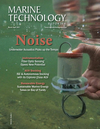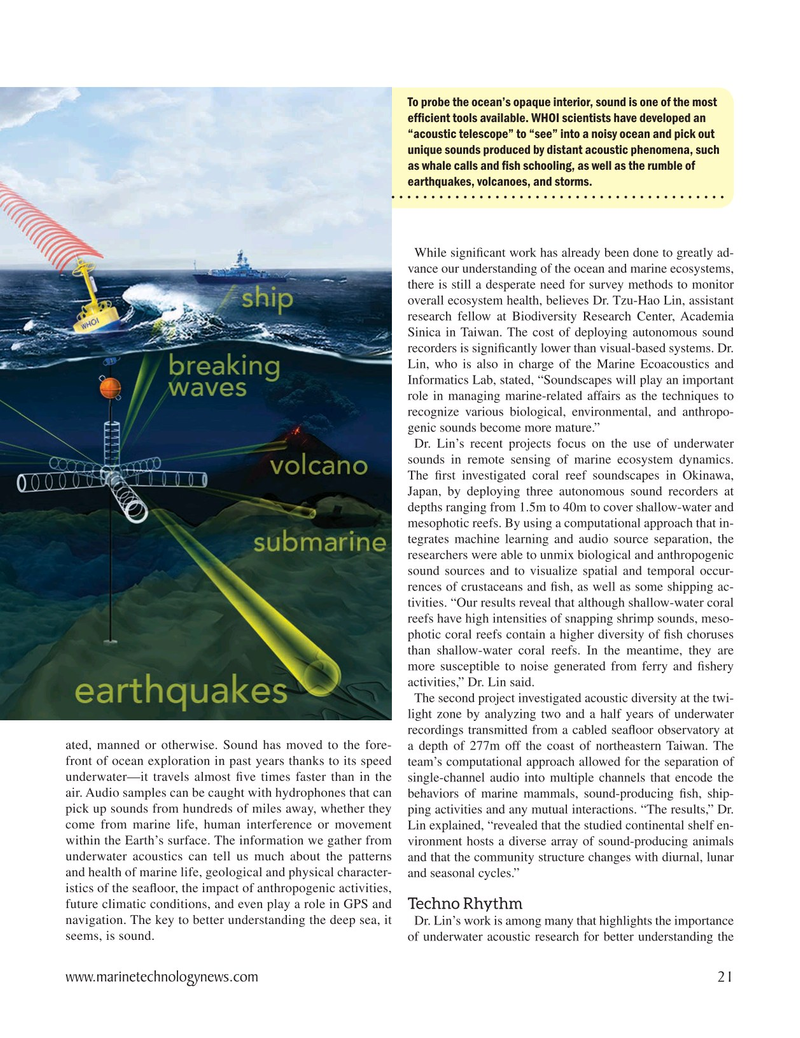
Page 21: of Marine Technology Magazine (March 2021)
Oceanographic Instrumentation & Sensors
Read this page in Pdf, Flash or Html5 edition of March 2021 Marine Technology Magazine
To probe the ocean’s opaque interior, sound is one of the most ef? cient tools available. WHOI scientists have developed an “acoustic telescope” to “see” into a noisy ocean and pick out unique sounds produced by distant acoustic phenomena, such as whale calls and ? sh schooling, as well as the rumble of earthquakes, volcanoes, and storms.
While signi? cant work has already been done to greatly ad- vance our understanding of the ocean and marine ecosystems, there is still a desperate need for survey methods to monitor overall ecosystem health, believes Dr. Tzu-Hao Lin, assistant research fellow at Biodiversity Research Center, Academia
Sinica in Taiwan. The cost of deploying autonomous sound recorders is signi? cantly lower than visual-based systems. Dr.
Lin, who is also in charge of the Marine Ecoacoustics and
Informatics Lab, stated, “Soundscapes will play an important role in managing marine-related affairs as the techniques to recognize various biological, environmental, and anthropo- genic sounds become more mature.”
Dr. Lin’s recent projects focus on the use of underwater sounds in remote sensing of marine ecosystem dynamics.
The ? rst investigated coral reef soundscapes in Okinawa,
Japan, by deploying three autonomous sound recorders at depths ranging from 1.5m to 40m to cover shallow-water and mesophotic reefs. By using a computational approach that in- tegrates machine learning and audio source separation, the researchers were able to unmix biological and anthropogenic sound sources and to visualize spatial and temporal occur- rences of crustaceans and ? sh, as well as some shipping ac- tivities. “Our results reveal that although shallow-water coral reefs have high intensities of snapping shrimp sounds, meso- photic coral reefs contain a higher diversity of ? sh choruses than shallow-water coral reefs. In the meantime, they are more susceptible to noise generated from ferry and ? shery activities,” Dr. Lin said.
The second project investigated acoustic diversity at the twi- light zone by analyzing two and a half years of underwater recordings transmitted from a cabled sea? oor observatory at ated, manned or otherwise. Sound has moved to the fore- a depth of 277m off the coast of northeastern Taiwan. The front of ocean exploration in past years thanks to its speed team’s computational approach allowed for the separation of underwater—it travels almost ? ve times faster than in the single-channel audio into multiple channels that encode the air. Audio samples can be caught with hydrophones that can behaviors of marine mammals, sound-producing ? sh, ship- pick up sounds from hundreds of miles away, whether they ping activities and any mutual interactions. “The results,” Dr. come from marine life, human interference or movement Lin explained, “revealed that the studied continental shelf en- within the Earth’s surface. The information we gather from vironment hosts a diverse array of sound-producing animals underwater acoustics can tell us much about the patterns and that the community structure changes with diurnal, lunar and health of marine life, geological and physical character- and seasonal cycles.” istics of the sea? oor, the impact of anthropogenic activities, future climatic conditions, and even play a role in GPS and
Techno Rhythm navigation. The key to better understanding the deep sea, it Dr. Lin’s work is among many that highlights the importance seems, is sound. of underwater acoustic research for better understanding the www.marinetechnologynews.com 21
MTR #3 (18-33).indd 21 3/22/2021 6:46:44 PM

 20
20

 22
22
